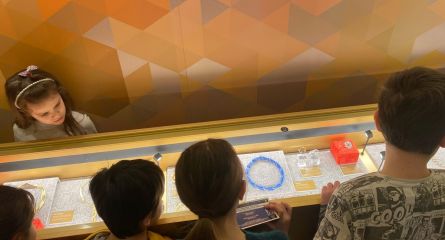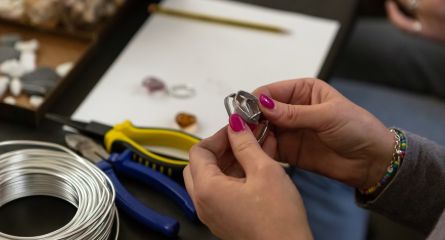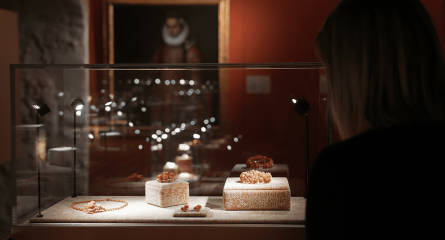For the halls of the Icons Room of the Jewelry Museum in Vicenza (o da lasciare Museo del Gioiello) we decided to display only vintage pieces, given our family tradition, and, in particular, jewels spanning from 1600 to 1930. The objects we display are part of our private collection, so they will be shown for the first time for visitors who love vintage and classic jewels. The choice we made for the Icons Room of the Jewelry Museum in Vicenza is surely an eclectic one. We chose jewels which date back from the 17th century up to the 1930s. The countries of origin are very different, we see many European jewels and some American jewel. Surely most are French jewels. The common trait in our choices is that of objects which are a depiction or have a main character. The most representative is a jewel which is actually an icon, a holy figure. Starting from that, we chose jewels that portray classic characters, or jewels that depict landscapes. So, we display jewels which are icons in a literal sense, and also jewels which become iconic and symbols of an era.
For the halls of the Icons Room of the Jewelry Museum in Vicenza (o da lasciare Museo del Gioiello) we decided to display only vintage pieces, given our family tradition, and, in particular, jewels spanning from 1600 to 1930. The objects we display are part of our private collection, so they will be shown for the first time for visitors who love vintage and classic jewels. The choice we made for the Icons Room of the Jewelry Museum in Vicenza is surely an eclectic one. We chose jewels which date back from the 17th century up to the 1930s. The countries of origin are very different, we see many European jewels and some American jewel. Surely most are French jewels. The common trait in our choices is that of objects which are a depiction or have a main character. The most representative is a jewel which is actually an icon, a holy figure. Starting from that, we chose jewels that portray classic characters, or jewels that depict landscapes. So, we display jewels which are icons in a literal sense, and also jewels which become iconic and symbols of an era.
Icons are narrative jewels able to tell exceptional stories through precious details and unforgettable particulars. This selection is dedicated to Europe: nineteenth century mountings, enamels and platinum geometries, sacred representations and mythological figures, profane portraits and symbols that recall historical characters.
Ciondolo, 1890, Francia
Mellerio dit Mellers
1890, France
pendant in yellow gold with imperial topaz
pendant
yellow gold, silver, diamonds, imperial topaz, rubies, natural pearls, emeralds, sapphires, enamels
gioielleria pennisi
The pendant is made in yellow gold with silver reinforcement; a frame of old cut diamonds surmounted by a crown, holds a conspicuous imperial topaz. The uniqueness of the item lies in the fact that the topaz was engraved and enamelled with a portrait of the Virgin with Child. The image, made in extremely fine multi-coloured enamels painted on gold, is further embellished by diamond roses and tiny precious stones. Below this there is a degradé of natural drop pearls of rare perfection. The jewel came to us inside an antique display case as if its function over time had become an altarpiece for prayer.
Croce
17th century, Portugal
yellow gold and enamel cross
cross
yellow gold, enamels
maria paola pennisi
The oldest jewellery in the Room is, in fact, a Portuguese devotional item that is extremely difficult to find nowadays but which was rather common in that area in the 16th and 17th centuries. The yellow gold cross with white and green enamel decorations shows the figure of a haloed Christ with a skull at his feet. The surface of the gold is carved on the front and back to contain the multi-coloured decorations.
Bracciale con api napoleoniche
19th century, France
bracelet in yellow gold and enamels with napoleonic bees in old-cut diamonds
bracelet
yellow gold, enamels, diamonds
gioielleria pennisi
An item of jewellery that has considerable symbolic content is the yellow gold bracelet with diamond-studded bees and guilloché enamelling in its original blue velvet box with Napoleon’s monogram. Bees have always been used in heraldry, not only as a symbol of industriousness, work and sweetness but also of immortality and resurrection.
Parure Egyptian Revival
19th century, Rome
egyptian revival micro-mosaic
set in yellow gold
set
yellow gold, glass paste
maria paola pennisi
The demi-parure comprising earrings and pendant with a figure of a Pharaoh has entirely Italian roots. The micro-mosaic of which the images are composed is an elegant example of this technique presented for the first time by Giacomo Raffaelli in 1775. This minute mosaic, still produced today, was made of tiny, spun enamel tiles with a less than one millimetre section. The micro tiles were fixed together with a mastic called Roman stucco which was a mixture of lime, travertine powder and linseed oil. The support was generally in copper, hard stone or opaline glass.
Parure Egyptian Revival
1920
Egyptian revival set in platinum and diamonds with egyptian deities in yellow gold
set
platinum, diamonds, yellow gold
gioielleria pennisi
The set on display here is a refined example of manufacture in platinum with diamonds totalling about 33.40 carats. Ring, bracelet and brooch are decorated with tiny, yellow gold sculptures of Osiris and Isis, Nut and Ra. All of the figures seem to have been modelled from original Egyptian artefacts dating back to 530 BC found in Saqqara in the 19th century and now in Cairo Museum.
Parure fer de Berlin
1840
fer de berlin set with cameos representing mythological figures
set
yellow gold, iron
private collection
Cameos were particularly popular from the end of the 18th century and throughout the 19th, so much so that the most varied materials were carved to cope with the enormous market demand. Collecting ancient cameos became a popular pastime among the well-to-do classes and were often copied by new generation artists and numerous imitations in ceramic and other materials appeared on the market. Therefore cameos can be found on materials that are extremely noble and hard to sculpture, such as emeralds and sapphires, as well as on poor and malleable materials.













Follow us on social networks
Subscribe to the newsletter